ITECH1104: Cloud and Enterprise Computing - ICT in Banks Report
VerifiedAdded on 2022/11/13
|7
|1771
|123
Report
AI Summary
This report investigates the application of Information and Communication Technology (ICT) within the banking sector, focusing on the utilization of both mainframe and cloud technologies. The report explores the core business services offered by banks, including individual banking, business banking, digital marketing, and loan services, highlighting the crucial role of ICT in these areas. It delves into the specific ICT workload types required by banks, such as batch, transactional, and analysis workloads, and how they are managed using mainframes and cloud services. The benefits of adopting cloud technologies, including improved manageability and accessibility, are discussed, along with the reasons why major banks continue to rely on mainframes for their processing power, security, and reliability. The report also examines the integration of cloud and mobile technologies, and their impact on banking operations and customer services. The document is a student's report on ICT in banks, focusing on cloud and mainframe technologies. Desklib provides past papers and solved assignments for students.
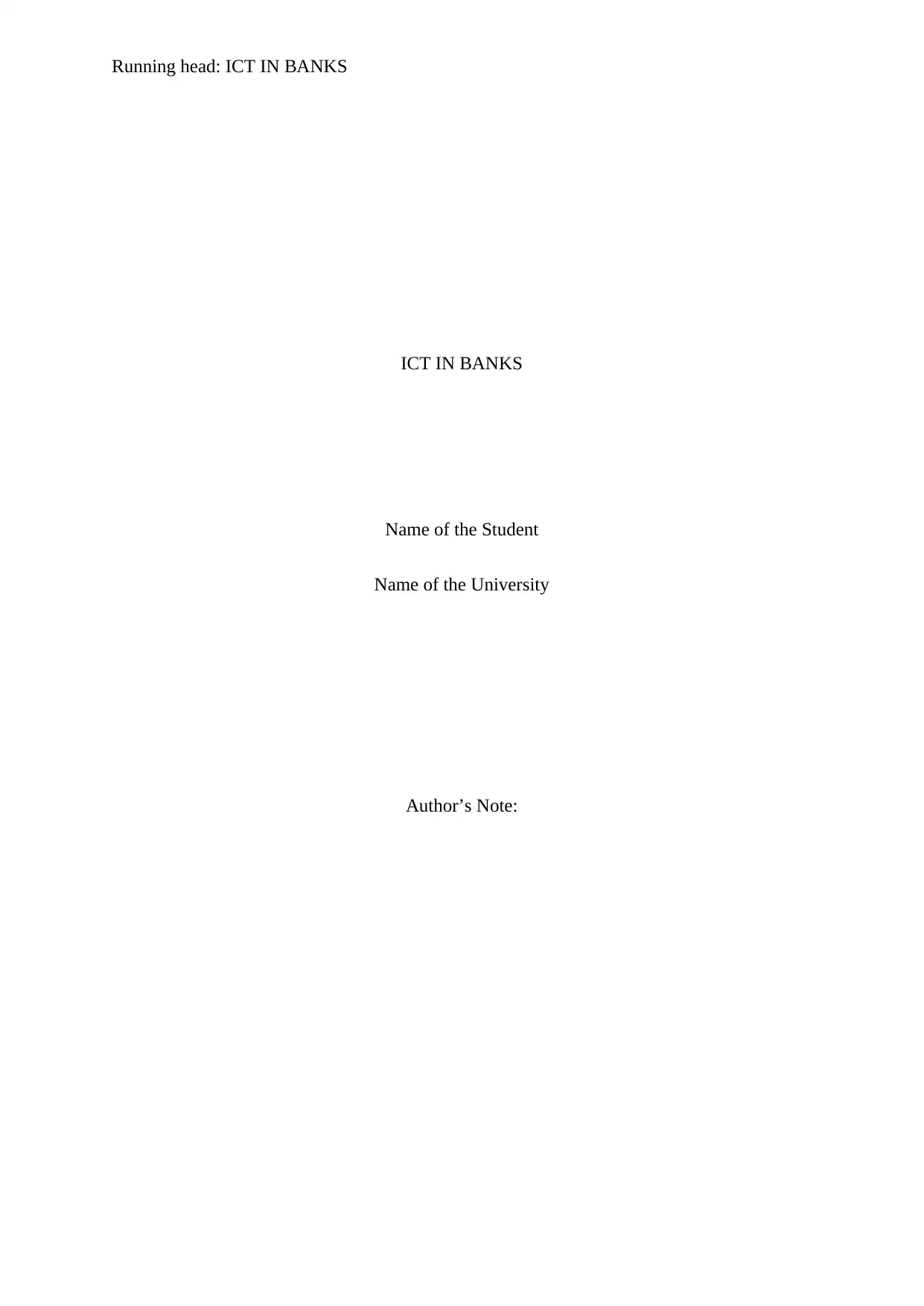
Running head: ICT IN BANKS
ICT IN BANKS
Name of the Student
Name of the University
Author’s Note:
ICT IN BANKS
Name of the Student
Name of the University
Author’s Note:
Paraphrase This Document
Need a fresh take? Get an instant paraphrase of this document with our AI Paraphraser
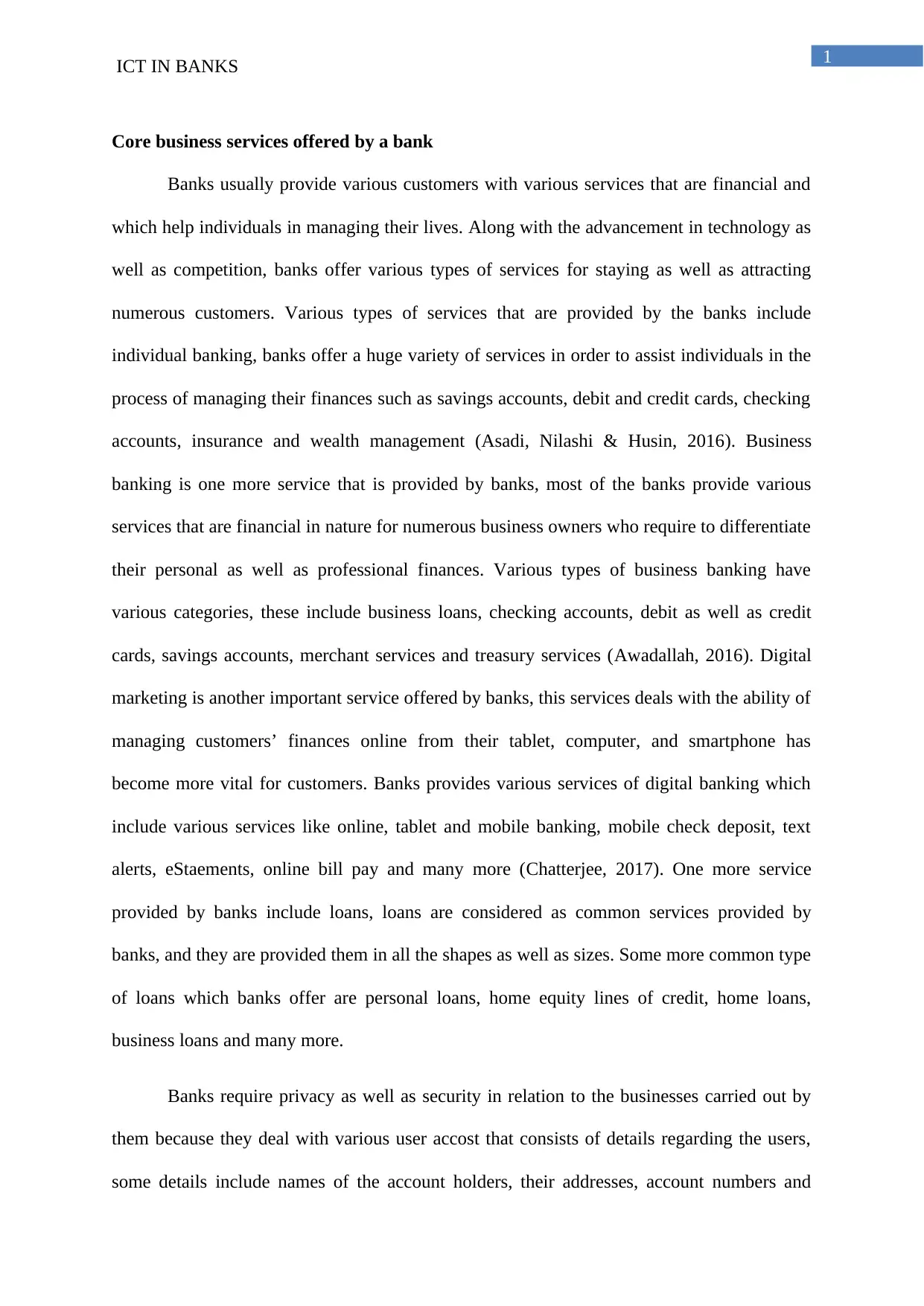
1
ICT IN BANKS
Core business services offered by a bank
Banks usually provide various customers with various services that are financial and
which help individuals in managing their lives. Along with the advancement in technology as
well as competition, banks offer various types of services for staying as well as attracting
numerous customers. Various types of services that are provided by the banks include
individual banking, banks offer a huge variety of services in order to assist individuals in the
process of managing their finances such as savings accounts, debit and credit cards, checking
accounts, insurance and wealth management (Asadi, Nilashi & Husin, 2016). Business
banking is one more service that is provided by banks, most of the banks provide various
services that are financial in nature for numerous business owners who require to differentiate
their personal as well as professional finances. Various types of business banking have
various categories, these include business loans, checking accounts, debit as well as credit
cards, savings accounts, merchant services and treasury services (Awadallah, 2016). Digital
marketing is another important service offered by banks, this services deals with the ability of
managing customers’ finances online from their tablet, computer, and smartphone has
become more vital for customers. Banks provides various services of digital banking which
include various services like online, tablet and mobile banking, mobile check deposit, text
alerts, eStaements, online bill pay and many more (Chatterjee, 2017). One more service
provided by banks include loans, loans are considered as common services provided by
banks, and they are provided them in all the shapes as well as sizes. Some more common type
of loans which banks offer are personal loans, home equity lines of credit, home loans,
business loans and many more.
Banks require privacy as well as security in relation to the businesses carried out by
them because they deal with various user accost that consists of details regarding the users,
some details include names of the account holders, their addresses, account numbers and
ICT IN BANKS
Core business services offered by a bank
Banks usually provide various customers with various services that are financial and
which help individuals in managing their lives. Along with the advancement in technology as
well as competition, banks offer various types of services for staying as well as attracting
numerous customers. Various types of services that are provided by the banks include
individual banking, banks offer a huge variety of services in order to assist individuals in the
process of managing their finances such as savings accounts, debit and credit cards, checking
accounts, insurance and wealth management (Asadi, Nilashi & Husin, 2016). Business
banking is one more service that is provided by banks, most of the banks provide various
services that are financial in nature for numerous business owners who require to differentiate
their personal as well as professional finances. Various types of business banking have
various categories, these include business loans, checking accounts, debit as well as credit
cards, savings accounts, merchant services and treasury services (Awadallah, 2016). Digital
marketing is another important service offered by banks, this services deals with the ability of
managing customers’ finances online from their tablet, computer, and smartphone has
become more vital for customers. Banks provides various services of digital banking which
include various services like online, tablet and mobile banking, mobile check deposit, text
alerts, eStaements, online bill pay and many more (Chatterjee, 2017). One more service
provided by banks include loans, loans are considered as common services provided by
banks, and they are provided them in all the shapes as well as sizes. Some more common type
of loans which banks offer are personal loans, home equity lines of credit, home loans,
business loans and many more.
Banks require privacy as well as security in relation to the businesses carried out by
them because they deal with various user accost that consists of details regarding the users,
some details include names of the account holders, their addresses, account numbers and
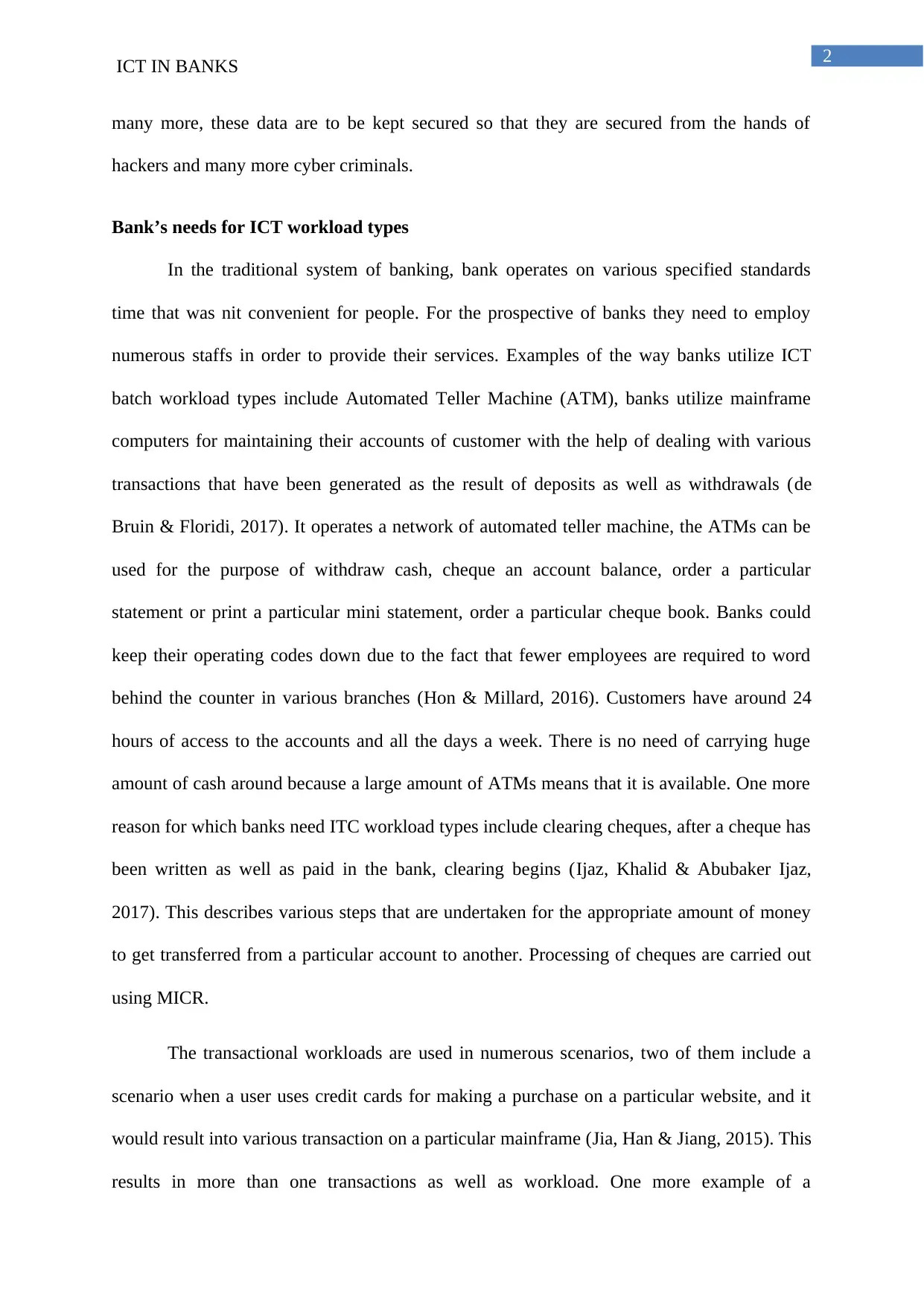
2
ICT IN BANKS
many more, these data are to be kept secured so that they are secured from the hands of
hackers and many more cyber criminals.
Bank’s needs for ICT workload types
In the traditional system of banking, bank operates on various specified standards
time that was nit convenient for people. For the prospective of banks they need to employ
numerous staffs in order to provide their services. Examples of the way banks utilize ICT
batch workload types include Automated Teller Machine (ATM), banks utilize mainframe
computers for maintaining their accounts of customer with the help of dealing with various
transactions that have been generated as the result of deposits as well as withdrawals (de
Bruin & Floridi, 2017). It operates a network of automated teller machine, the ATMs can be
used for the purpose of withdraw cash, cheque an account balance, order a particular
statement or print a particular mini statement, order a particular cheque book. Banks could
keep their operating codes down due to the fact that fewer employees are required to word
behind the counter in various branches (Hon & Millard, 2016). Customers have around 24
hours of access to the accounts and all the days a week. There is no need of carrying huge
amount of cash around because a large amount of ATMs means that it is available. One more
reason for which banks need ITC workload types include clearing cheques, after a cheque has
been written as well as paid in the bank, clearing begins (Ijaz, Khalid & Abubaker Ijaz,
2017). This describes various steps that are undertaken for the appropriate amount of money
to get transferred from a particular account to another. Processing of cheques are carried out
using MICR.
The transactional workloads are used in numerous scenarios, two of them include a
scenario when a user uses credit cards for making a purchase on a particular website, and it
would result into various transaction on a particular mainframe (Jia, Han & Jiang, 2015). This
results in more than one transactions as well as workload. One more example of a
ICT IN BANKS
many more, these data are to be kept secured so that they are secured from the hands of
hackers and many more cyber criminals.
Bank’s needs for ICT workload types
In the traditional system of banking, bank operates on various specified standards
time that was nit convenient for people. For the prospective of banks they need to employ
numerous staffs in order to provide their services. Examples of the way banks utilize ICT
batch workload types include Automated Teller Machine (ATM), banks utilize mainframe
computers for maintaining their accounts of customer with the help of dealing with various
transactions that have been generated as the result of deposits as well as withdrawals (de
Bruin & Floridi, 2017). It operates a network of automated teller machine, the ATMs can be
used for the purpose of withdraw cash, cheque an account balance, order a particular
statement or print a particular mini statement, order a particular cheque book. Banks could
keep their operating codes down due to the fact that fewer employees are required to word
behind the counter in various branches (Hon & Millard, 2016). Customers have around 24
hours of access to the accounts and all the days a week. There is no need of carrying huge
amount of cash around because a large amount of ATMs means that it is available. One more
reason for which banks need ITC workload types include clearing cheques, after a cheque has
been written as well as paid in the bank, clearing begins (Ijaz, Khalid & Abubaker Ijaz,
2017). This describes various steps that are undertaken for the appropriate amount of money
to get transferred from a particular account to another. Processing of cheques are carried out
using MICR.
The transactional workloads are used in numerous scenarios, two of them include a
scenario when a user uses credit cards for making a purchase on a particular website, and it
would result into various transaction on a particular mainframe (Jia, Han & Jiang, 2015). This
results in more than one transactions as well as workload. One more example of a
⊘ This is a preview!⊘
Do you want full access?
Subscribe today to unlock all pages.

Trusted by 1+ million students worldwide
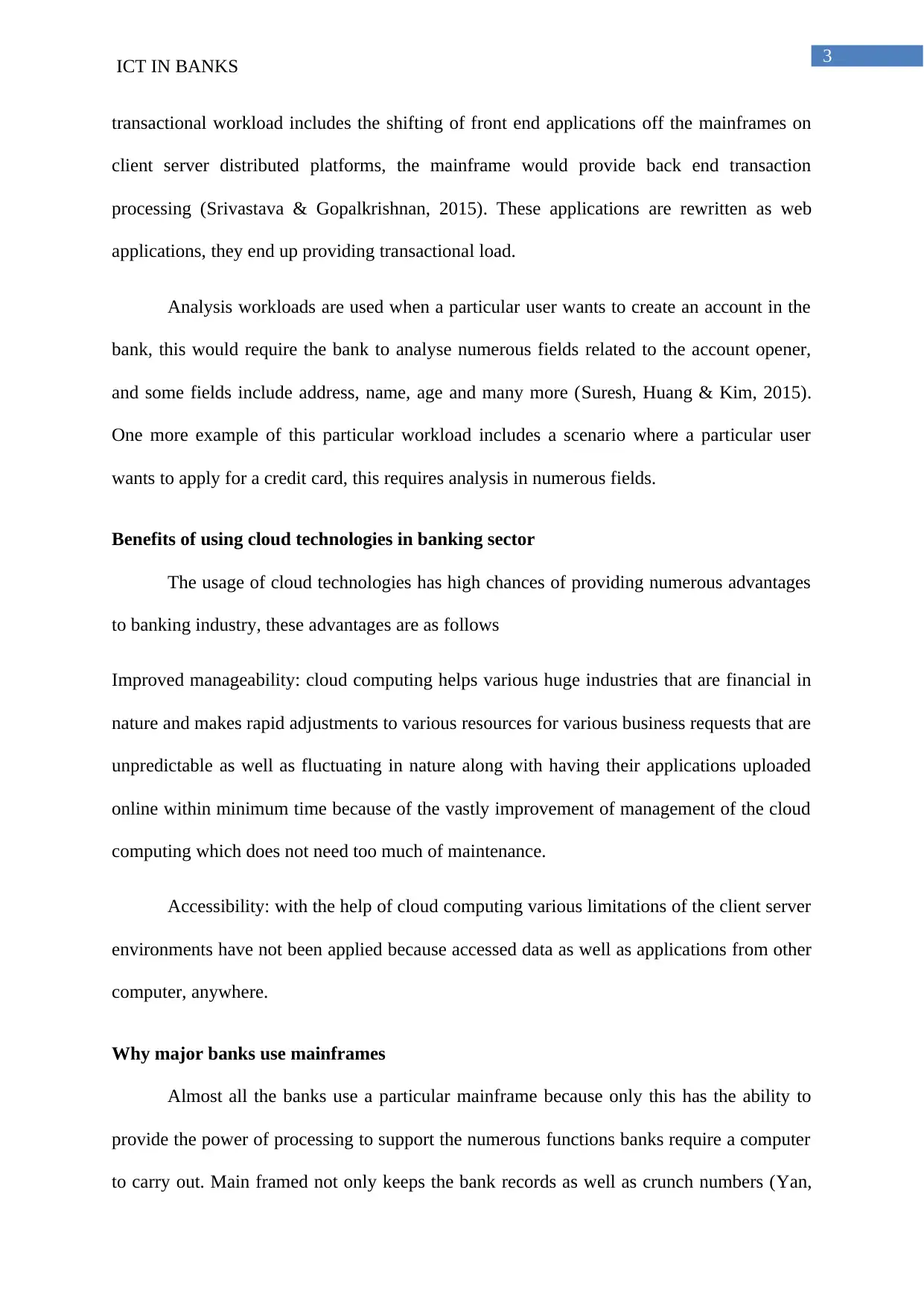
3
ICT IN BANKS
transactional workload includes the shifting of front end applications off the mainframes on
client server distributed platforms, the mainframe would provide back end transaction
processing (Srivastava & Gopalkrishnan, 2015). These applications are rewritten as web
applications, they end up providing transactional load.
Analysis workloads are used when a particular user wants to create an account in the
bank, this would require the bank to analyse numerous fields related to the account opener,
and some fields include address, name, age and many more (Suresh, Huang & Kim, 2015).
One more example of this particular workload includes a scenario where a particular user
wants to apply for a credit card, this requires analysis in numerous fields.
Benefits of using cloud technologies in banking sector
The usage of cloud technologies has high chances of providing numerous advantages
to banking industry, these advantages are as follows
Improved manageability: cloud computing helps various huge industries that are financial in
nature and makes rapid adjustments to various resources for various business requests that are
unpredictable as well as fluctuating in nature along with having their applications uploaded
online within minimum time because of the vastly improvement of management of the cloud
computing which does not need too much of maintenance.
Accessibility: with the help of cloud computing various limitations of the client server
environments have not been applied because accessed data as well as applications from other
computer, anywhere.
Why major banks use mainframes
Almost all the banks use a particular mainframe because only this has the ability to
provide the power of processing to support the numerous functions banks require a computer
to carry out. Main framed not only keeps the bank records as well as crunch numbers (Yan,
ICT IN BANKS
transactional workload includes the shifting of front end applications off the mainframes on
client server distributed platforms, the mainframe would provide back end transaction
processing (Srivastava & Gopalkrishnan, 2015). These applications are rewritten as web
applications, they end up providing transactional load.
Analysis workloads are used when a particular user wants to create an account in the
bank, this would require the bank to analyse numerous fields related to the account opener,
and some fields include address, name, age and many more (Suresh, Huang & Kim, 2015).
One more example of this particular workload includes a scenario where a particular user
wants to apply for a credit card, this requires analysis in numerous fields.
Benefits of using cloud technologies in banking sector
The usage of cloud technologies has high chances of providing numerous advantages
to banking industry, these advantages are as follows
Improved manageability: cloud computing helps various huge industries that are financial in
nature and makes rapid adjustments to various resources for various business requests that are
unpredictable as well as fluctuating in nature along with having their applications uploaded
online within minimum time because of the vastly improvement of management of the cloud
computing which does not need too much of maintenance.
Accessibility: with the help of cloud computing various limitations of the client server
environments have not been applied because accessed data as well as applications from other
computer, anywhere.
Why major banks use mainframes
Almost all the banks use a particular mainframe because only this has the ability to
provide the power of processing to support the numerous functions banks require a computer
to carry out. Main framed not only keeps the bank records as well as crunch numbers (Yan,
Paraphrase This Document
Need a fresh take? Get an instant paraphrase of this document with our AI Paraphraser
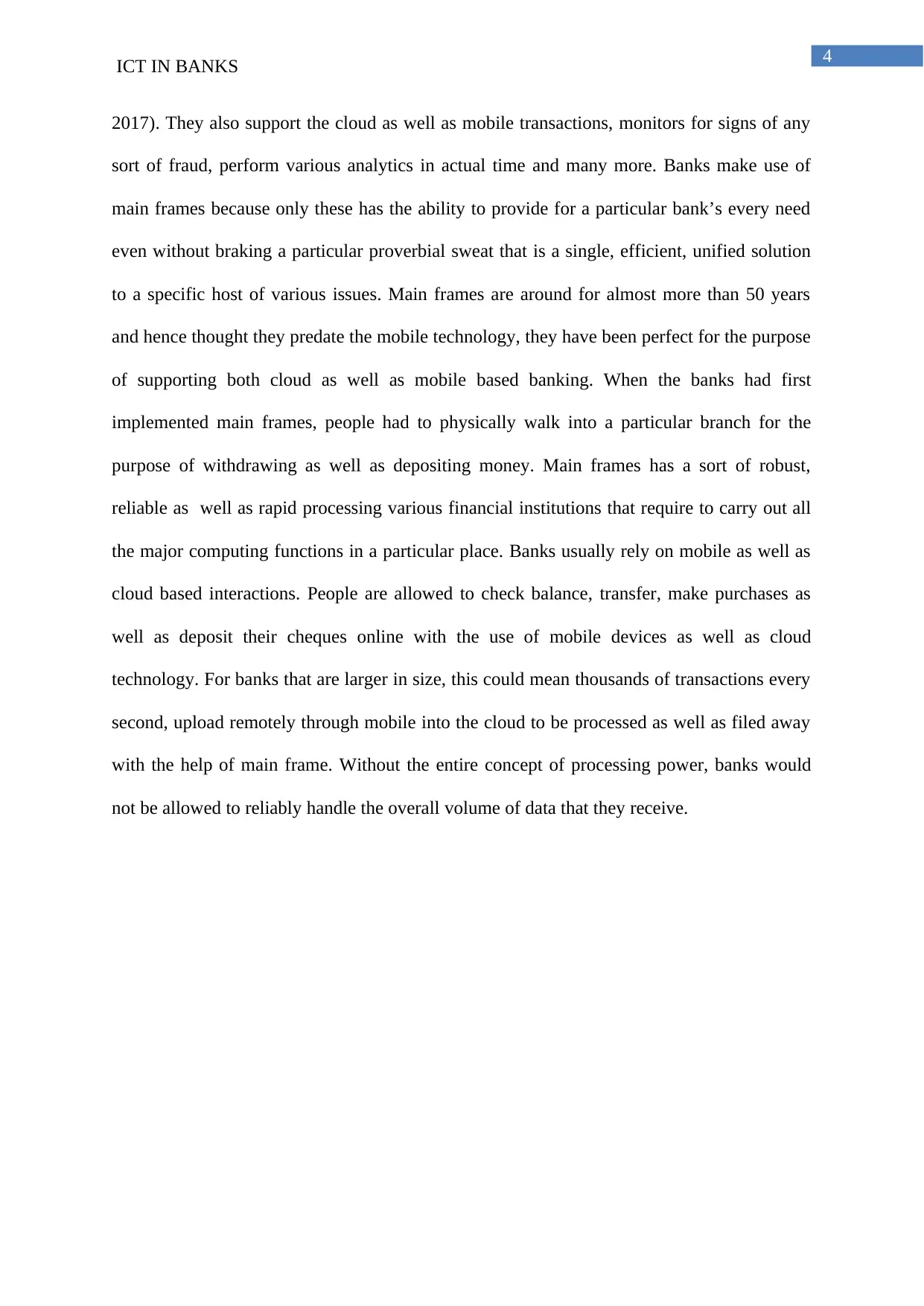
4
ICT IN BANKS
2017). They also support the cloud as well as mobile transactions, monitors for signs of any
sort of fraud, perform various analytics in actual time and many more. Banks make use of
main frames because only these has the ability to provide for a particular bank’s every need
even without braking a particular proverbial sweat that is a single, efficient, unified solution
to a specific host of various issues. Main frames are around for almost more than 50 years
and hence thought they predate the mobile technology, they have been perfect for the purpose
of supporting both cloud as well as mobile based banking. When the banks had first
implemented main frames, people had to physically walk into a particular branch for the
purpose of withdrawing as well as depositing money. Main frames has a sort of robust,
reliable as well as rapid processing various financial institutions that require to carry out all
the major computing functions in a particular place. Banks usually rely on mobile as well as
cloud based interactions. People are allowed to check balance, transfer, make purchases as
well as deposit their cheques online with the use of mobile devices as well as cloud
technology. For banks that are larger in size, this could mean thousands of transactions every
second, upload remotely through mobile into the cloud to be processed as well as filed away
with the help of main frame. Without the entire concept of processing power, banks would
not be allowed to reliably handle the overall volume of data that they receive.
ICT IN BANKS
2017). They also support the cloud as well as mobile transactions, monitors for signs of any
sort of fraud, perform various analytics in actual time and many more. Banks make use of
main frames because only these has the ability to provide for a particular bank’s every need
even without braking a particular proverbial sweat that is a single, efficient, unified solution
to a specific host of various issues. Main frames are around for almost more than 50 years
and hence thought they predate the mobile technology, they have been perfect for the purpose
of supporting both cloud as well as mobile based banking. When the banks had first
implemented main frames, people had to physically walk into a particular branch for the
purpose of withdrawing as well as depositing money. Main frames has a sort of robust,
reliable as well as rapid processing various financial institutions that require to carry out all
the major computing functions in a particular place. Banks usually rely on mobile as well as
cloud based interactions. People are allowed to check balance, transfer, make purchases as
well as deposit their cheques online with the use of mobile devices as well as cloud
technology. For banks that are larger in size, this could mean thousands of transactions every
second, upload remotely through mobile into the cloud to be processed as well as filed away
with the help of main frame. Without the entire concept of processing power, banks would
not be allowed to reliably handle the overall volume of data that they receive.
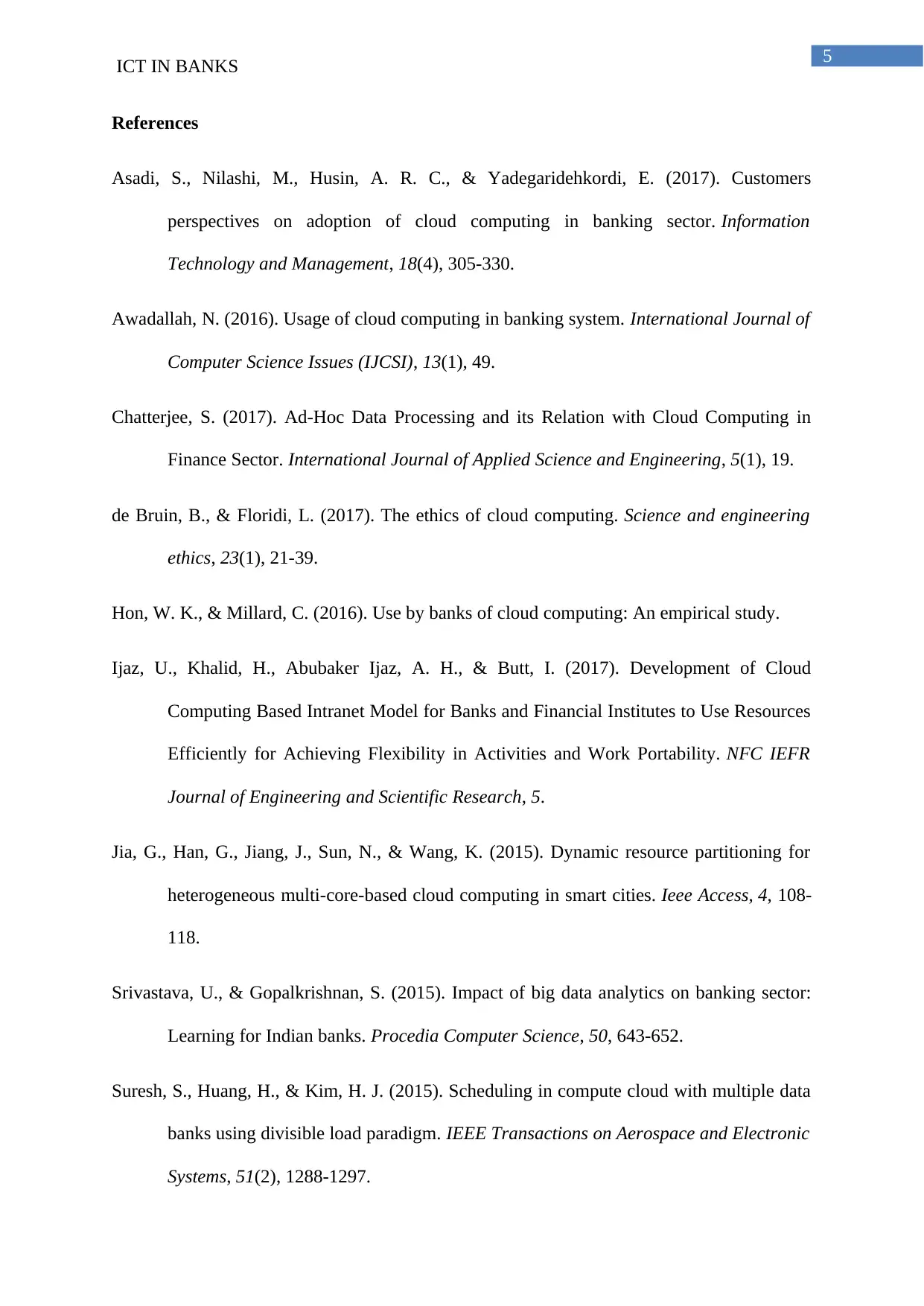
5
ICT IN BANKS
References
Asadi, S., Nilashi, M., Husin, A. R. C., & Yadegaridehkordi, E. (2017). Customers
perspectives on adoption of cloud computing in banking sector. Information
Technology and Management, 18(4), 305-330.
Awadallah, N. (2016). Usage of cloud computing in banking system. International Journal of
Computer Science Issues (IJCSI), 13(1), 49.
Chatterjee, S. (2017). Ad-Hoc Data Processing and its Relation with Cloud Computing in
Finance Sector. International Journal of Applied Science and Engineering, 5(1), 19.
de Bruin, B., & Floridi, L. (2017). The ethics of cloud computing. Science and engineering
ethics, 23(1), 21-39.
Hon, W. K., & Millard, C. (2016). Use by banks of cloud computing: An empirical study.
Ijaz, U., Khalid, H., Abubaker Ijaz, A. H., & Butt, I. (2017). Development of Cloud
Computing Based Intranet Model for Banks and Financial Institutes to Use Resources
Efficiently for Achieving Flexibility in Activities and Work Portability. NFC IEFR
Journal of Engineering and Scientific Research, 5.
Jia, G., Han, G., Jiang, J., Sun, N., & Wang, K. (2015). Dynamic resource partitioning for
heterogeneous multi-core-based cloud computing in smart cities. Ieee Access, 4, 108-
118.
Srivastava, U., & Gopalkrishnan, S. (2015). Impact of big data analytics on banking sector:
Learning for Indian banks. Procedia Computer Science, 50, 643-652.
Suresh, S., Huang, H., & Kim, H. J. (2015). Scheduling in compute cloud with multiple data
banks using divisible load paradigm. IEEE Transactions on Aerospace and Electronic
Systems, 51(2), 1288-1297.
ICT IN BANKS
References
Asadi, S., Nilashi, M., Husin, A. R. C., & Yadegaridehkordi, E. (2017). Customers
perspectives on adoption of cloud computing in banking sector. Information
Technology and Management, 18(4), 305-330.
Awadallah, N. (2016). Usage of cloud computing in banking system. International Journal of
Computer Science Issues (IJCSI), 13(1), 49.
Chatterjee, S. (2017). Ad-Hoc Data Processing and its Relation with Cloud Computing in
Finance Sector. International Journal of Applied Science and Engineering, 5(1), 19.
de Bruin, B., & Floridi, L. (2017). The ethics of cloud computing. Science and engineering
ethics, 23(1), 21-39.
Hon, W. K., & Millard, C. (2016). Use by banks of cloud computing: An empirical study.
Ijaz, U., Khalid, H., Abubaker Ijaz, A. H., & Butt, I. (2017). Development of Cloud
Computing Based Intranet Model for Banks and Financial Institutes to Use Resources
Efficiently for Achieving Flexibility in Activities and Work Portability. NFC IEFR
Journal of Engineering and Scientific Research, 5.
Jia, G., Han, G., Jiang, J., Sun, N., & Wang, K. (2015). Dynamic resource partitioning for
heterogeneous multi-core-based cloud computing in smart cities. Ieee Access, 4, 108-
118.
Srivastava, U., & Gopalkrishnan, S. (2015). Impact of big data analytics on banking sector:
Learning for Indian banks. Procedia Computer Science, 50, 643-652.
Suresh, S., Huang, H., & Kim, H. J. (2015). Scheduling in compute cloud with multiple data
banks using divisible load paradigm. IEEE Transactions on Aerospace and Electronic
Systems, 51(2), 1288-1297.
⊘ This is a preview!⊘
Do you want full access?
Subscribe today to unlock all pages.

Trusted by 1+ million students worldwide
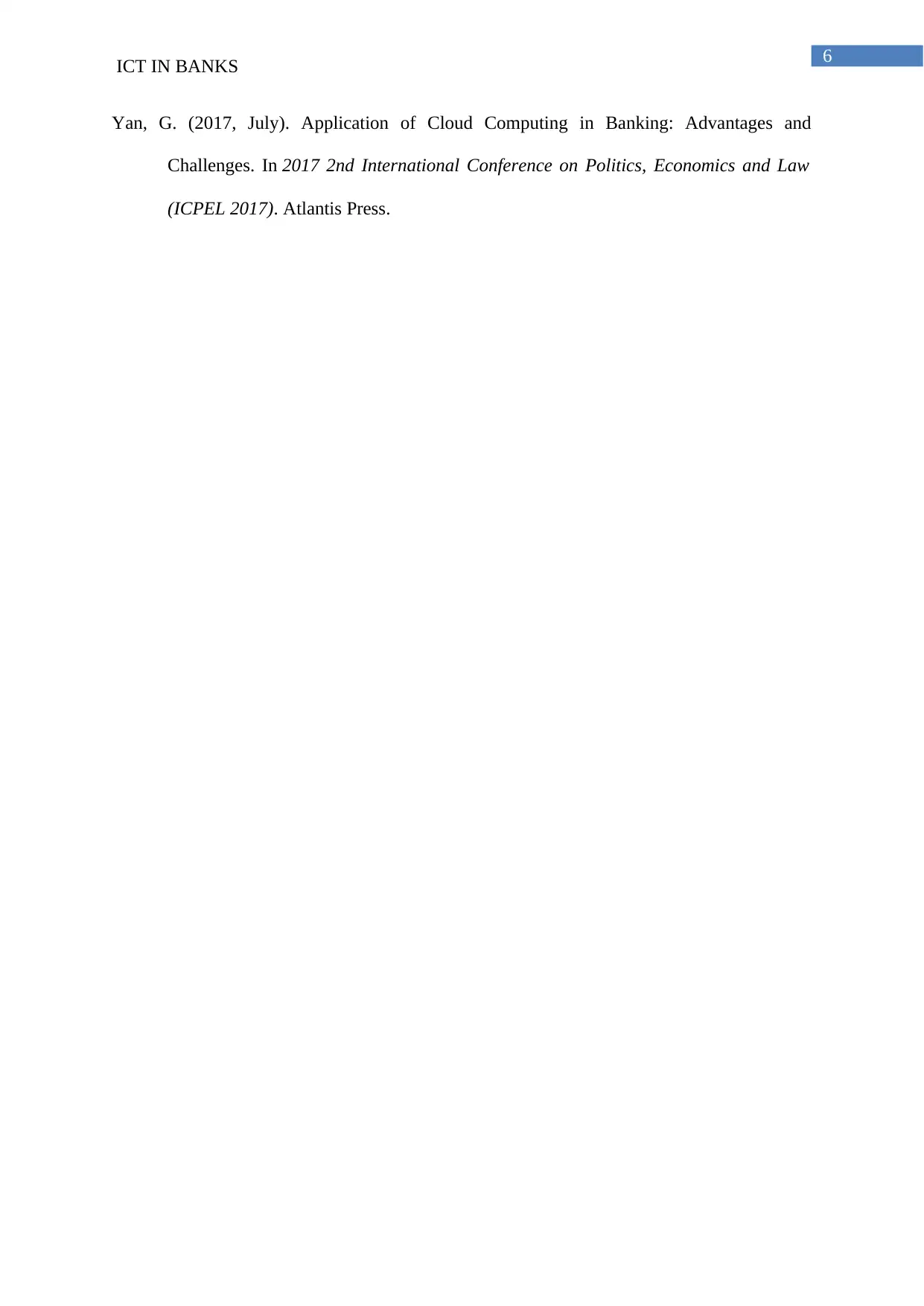
6
ICT IN BANKS
Yan, G. (2017, July). Application of Cloud Computing in Banking: Advantages and
Challenges. In 2017 2nd International Conference on Politics, Economics and Law
(ICPEL 2017). Atlantis Press.
ICT IN BANKS
Yan, G. (2017, July). Application of Cloud Computing in Banking: Advantages and
Challenges. In 2017 2nd International Conference on Politics, Economics and Law
(ICPEL 2017). Atlantis Press.
1 out of 7
Related Documents
Your All-in-One AI-Powered Toolkit for Academic Success.
+13062052269
info@desklib.com
Available 24*7 on WhatsApp / Email
![[object Object]](/_next/static/media/star-bottom.7253800d.svg)
Unlock your academic potential
Copyright © 2020–2025 A2Z Services. All Rights Reserved. Developed and managed by ZUCOL.




